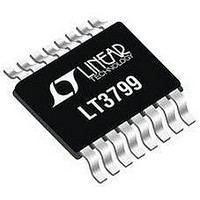LT3799EMSE#PBF Linear Technology, LT3799EMSE#PBF Datasheet - Page 9

LT3799EMSE#PBF
Manufacturer Part Number
LT3799EMSE#PBF
Description
IC, LED DRVR, MSOP-16
Manufacturer
Linear Technology
Datasheet
1.LT3799EMSEPBF.pdf
(20 pages)
Specifications of LT3799EMSE#PBF
Led Driver Application
High Power LED Driver, Automotive Lighting
No. Of Outputs
1
Output Current
3A
Input Voltage
18V
Dimming Control Type
Analog
Topology
Flyback
Rohs Compliant
Yes
Lead Free Status / RoHS Status
Lead free / RoHS Compliant
Available stocks
Company
Part Number
Manufacturer
Quantity
Price
OPERATION
The LT3799 is a current mode switching controller IC
designed specifically for generating an average current
output in an isolated flyback topology. The special problem
normally encountered in such circuits is that information
relating to the output voltage and current on the isolated
secondary side of the transformer must be communicated
to the primary side in order to maintain regulation. Histori-
cally, this has been done with an opto-isolator. The LT3799
uses a novel method of using the external MOSFETs peak
current information from the sense resistor to calculate
the output current of a flyback converter without the need
of an opto-coupler. In addition, it also detects open LED
conditions by examining the third winding voltage when
the main power switch is off.
Power factor has become an important specification for
lighting. A power factor of one is achieved if the current
drawn is proportional to the input voltage. The LT3799
modulates the peak current limit with a scaled version of
the input voltage. This technique provides power factors
of 0.97 or greater.
The Block Diagram shows an overall view of the system.
The external components are in a flyback topology con-
figuration. The third winding senses the output voltage
and also supplies power to the part in steady-state opera-
tion. The V
generates 10V at the INTV
consists of an error amplifier, a multiplier, a transmission
gate, a current comparator, a low output current oscillator
and a master latch, which will be explained in the follow-
ing sections. The part also features a sample-and-hold
to detect open LED conditions, along with a FAULT pin. A
comparator is used to detect discontinuous conduction
mode (DCM) with a cap connected to the third winding.
The part features a 1.9A gate driver.
The LT3799 employs a micropower hysteretic start-up
feature to allow the part to work at any combination of
input and output voltages. In the Block Diagram, R3 is used
to stand off the high voltage supply voltage. The internal
LDO starts to supply current to the INTV
above 23V. The V
the current from R3. When V
in regulation at 10V, the part will began to charge the CT
IN
pin supplies power to an internal LDO that
IN
and INTV
CC
pin. The novel control circuitry
IN
CC
exceeds 23V and INTV
capacitors are charged by
CC
when V
IN
CC
is
is
pin with 10μA. Once the CT pin reaches 340mV, switching
begins. The V
plenty of flexibility with the input and output capacitor
values. The third winding provides power to V
voltage is higher than the V
provided for fault protection and can sink up to 15mA of
current when V
During a typical cycle, the gate driver turns the external
MOSFET on and a current flows through the primary
winding. This current increases at a rate proportional
to the input voltage and inversely proportional to the
magnetizing inductance of the transformer. The control
loop determines the maximum current and the current
comparator turns the switch off when the current level
is reached. When the switch turns off, the energy in the
core of the transformer flows out the secondary winding
through the output diode, D1. This current decreases at a
rate proportional to the output voltage. When the current
decreases to zero, the output diode turns off and voltage
across the secondary winding starts to oscillate from the
parasitic capacitance and the magnetizing inductance of
the transformer. Since all windings have the same voltage
across them, the third winding rings too. The capacitor
connected to the DCM pin, C1, trips the comparator, A2,
which serves as a dv/dt detector, when the ringing occurs.
This timing information is used to calculate the output
current (description to follow). The dv/dt detector waits
for the ringing waveform to reach its minimum value and
then the switch turns back on. This switching behavior is
similar to zero volt switching and minimizes the amount of
energy lost when the switch is turned back on, improving
efficiency as much as 5%. Since this part operates on the
edge of continuous conduction mode and discontinuous
conduction mode, this operating mode is called critical
conduction mode (or boundary conduction mode).
Primary-Side Current Control Loop
The CTRL1/CTRL2/CTRL3 pins control the output current
of the flyback controller. To simplify the loop, assume
the V
1V, eliminating the multiplier from the control loop. The
error amplifier, A5, is configured as an integrator with
the external capacitor, C6. The COMP
IN_SENSE
IN
pin is held at a constant voltage above
IN
pin has 10.7V of hysteresis to allow for
is over 25V.
IN
voltage. A voltage shunt is
+
node voltage is
LT3799
IN
when its
9
3799f













